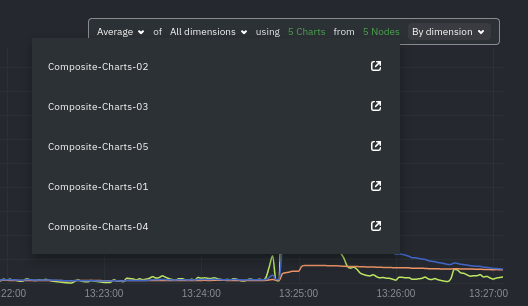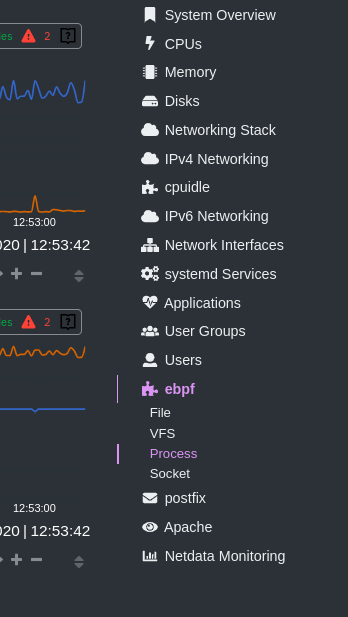minor fix, convert metadata of the learn to hidden sections Signed-off-by: Tasos Katsoulas <tasos@netdata.cloud>
12 KiB
Home
The Home tab provides a predefined dashboard of relevant information about entities in the War Room.
This tab will automatically present summarized information in an easily digestible display. You can see information about your nodes, data collection and retention stats, alerts, users and dashboards.
Overview
The Overview tab is another great way to monitor infrastructure using Netdata Cloud. While the interface might look similar to local dashboards served by an Agent Overview uses composite charts. These charts display real-time aggregated metrics from all the nodes (or a filtered selection) in a given War Room.
With Overview's composite charts, you can see your infrastructure from a single pane of glass, discover trends or anomalies, then drill down by grouping metrics by node and jumping to single-node dashboards for root cause analysis.
Single Node view
The Single Node view dashboard engine is the same as the Overview, meaning that it also uses composite charts, and displays real-time aggregated metrics from a specific node.
As mentioned above, the interface is similar to local dashboards served by an Agent but this dashboard also uses *
composite charts* which, in the case of a single node, will aggregate
multiple chart instances belonging to a context into a single chart. For example, on disk.io context it will get
into a single chart an aggregated view of each disk the node has.
Further tools provided in composite chart definiton bar will allow you to explore in more detail what is happening on each instance.
Before you get started
Only nodes with v1.25.0-127 or later of the the open-source Netdata monitoring agent can contribute to composite charts. If your node(s) use an earlier version of Netdata, you will see them marked as needs upgrade in various dropdowns.
See our update docs for the preferred update method based on how you installed Netdata.
Composite charts
The Overview uses composite charts, which aggregate metrics from all the nodes (or a filtered selection) in a given War Room.
Definition bar
Each composite chart has a definition bar to provide information about the following:
- Grouping option
- Aggregate function to be applied in case multiple data sources exist
- Instances
- Nodes
- Dimensions, and
- Aggregate function over time to be applied if one point in the chart consists of multiple data points aggregated
Group by dimension, node, or chart
Click on the dimension dropdown to change how a composite chart groups metrics.
The default option is by dimension, so that each line/area in the visualization is the aggregation of a single dimension. This provides a per dimension view of the data from all the nodes in the War Room, taking into account filtering criteria if defined.
A composite chart grouped by node visualizes a single metric across contributing nodes. If the composite chart has five contributing nodes, there will be five lines/areas. This is typically an absolute value of the sum of the dimensions over each node but there are some opinionated-but-valuable exceptions where a specific dimension is selected. Grouping by nodes allows you to quickly understand which nodes in your infrastructure are experiencing anomalous behavior.
A composite chart grouped by instance visualizes each instance of one software or hardware on a node and displays
these as a separate dimension. By grouping the
disk.io chart by instance, you can visualize the activity of each disk on each node that contributes to the
composite
chart.
Another very pertinent example is composite charts over contexts related to cgroups (VMs and containers). You have the means to change the default group by or apply filtering to get a better view into what data your are trying to analyze. For example, if you change the group by to instance you get a view with the data of all the instances (cgroups) that contribute to that chart. Then you can use further filtering tools to focus the data that is important to you and even save the result to your own dashboards.
Aggregate functions over data sources
Each chart uses an opinionated-but-valuable default aggregate function over the data sources. For example,
the system.cpu chart shows the
average for each dimension from every contributing chart, while the net.net chart shows the sum for each dimension
from every contributing chart, which can also come from multiple networking interfaces.
The following aggregate functions are available for each selected dimension:
- Average: Displays the average value from contributing nodes. If a composite chart has 5 nodes with the following
values for the
outdimension—-2.1,-5.5,-10.2,-15,-0.1—the composite chart displays a value of−6.58. - Sum: Displays the sum of contributed values. Using the same nodes, dimension, and values as above, the composite
chart displays a metric value of
-32.9. - Min: Displays a minimum value. For dimensions with positive values, the min is the value closest to zero. For charts with negative values, the min is the value with the largest magnitude.
- Max: Displays a maximum value. For dimensions with positive values, the max is the value with the largest magnitude. For charts with negative values, the max is the value closet to zero.
Dimensions
Select which dimensions to display on the composite chart. You can choose All dimensions, a single dimension, or any number of dimensions available on that context.
Instances
Click on X Instances to display a dropdown of instances and nodes contributing to that composite chart. Each line in the dropdown displays an instance name and the associated node's hostname.
Nodes
Click on X Nodes to display a dropdown of nodes contributing to that composite chart. Each line displays a hostname to help you identify which nodes contribute to a chart. You can also use this component to filter nodes directly on the chart.
If one or more nodes can't contribute to a given chart, the definition bar shows a warning symbol plus the number of
affected nodes, then lists them in the dropdown along with the associated error. Nodes might return errors because of
networking issues, a stopped netdata service, or because that node does not have any metrics for that context.
Aggregate functions over time
When the granularity of the data collected is higher than the plotted points on the chart an aggregation function over time is applied. By default the aggregation applied is average but the user can choose different options from the following:
- Min
- Max
- Average
- Sum
- Incremental sum (Delta)
- Standard deviation
- Median
- Single exponential smoothing
- Double exponential smoothing
- Coefficient variation
- Trimmed Median
* - Trimmed Mean
* - Percentile
**
:::info
*For Trimmed Median and Mean you can choose the percentage of data tha you want to focus on: 1%, 2%, 3%, 5%, 10%, 15%, 20% and 25%.**For Percentile you can specify the percentile you want to focus on: 25th, 50th, 75th, 80th, 90th, 95th, 97th, 98th and 99th.
:::
For more details on each, you can refer to our Agent's HTTP API details on Data Queries - Data Grouping.
Reset to defaults
Click on the 3-dot icon (⋮) on any chart, then Reset to Defaults, to reset the definition bar to its initial state.
Jump to single-node dashboards
Click on X Charts/X Nodes to display one of the two dropdowns that list the charts and nodes contributing to a given composite chart. For example, the nodes dropdown.
To jump to a single-node dashboard, click on the link icon  next to the
node you're interested in.
next to the
node you're interested in.
The single-node dashboard opens in a new tab. From there, you can continue to troubleshoot or run Metric Correlations for faster root cause analysis.
Add composite charts to a dashboard
Click on the 3-dot icon (⋮) on any chart, then click on Add to Dashboard. Click the + button for any dashboard you'd like to add this composite chart to, or create a new dashboard an initiate it with your chosen chart by entering the name and clicking New Dashboard.
Interacting with composite charts: pan, zoom, and resize
You can interact with composite charts as you would with other Netdata charts. You can use the controls beneath each chart to pan, zoom, or resize the chart, or use various combinations of the keyboard and mouse. See the chart interaction doc for details.
Menu
The Overview uses a similar menu to local Agent dashboards and single-node dashboards in Netdata Cloud, with sections and sub-menus aggregated from every contributing node. For example, even if only two nodes actively collect from and monitor an Apache web server, the Apache section still appears and displays composite charts from those two nodes.
One difference between the Overview's menu and those found in single-node dashboards or local Agent dashboards is that the Overview condenses multiple services, families, or instances into single sections, sub-menus, and associated charts.
For services, let's say you have two concurrent jobs with the web_log collector, one for Apache and another for Nginx. A single-node or local dashboard shows two section, web_log apache and web_log nginx, whereas the Overview condenses these into a single web_log section containing composite charts from both jobs.
The Overview also consdenses multiple families or multiple instances into a single all sub-menu and associated
charts. For example, if Node A has 5 disks, and Node B has 3, each disk contributes to a single disk.io composite
chart. The utility bar should show that there are 8 charts from 2 nodes contributing to that chart.
This action applies to disks, network devices, and other metric types that involve multiple instances of a piece of hardware or software. The Overview currently does not display metrics from filesystems. Read more about families and instances
Persistence of composite chart settings
When you change a composite chart via its definition bar, Netdata Cloud persists these settings in a query string attached to the URL in your browser. You can "save" these settings by bookmarking this particular URL, or share it with colleagues by having them copy-paste it into their browser.
What's next?
For another way to view an infrastructure from a high level, see the Nodes view.
If you need a refresher on how Netdata's charts work, see our doc on interacting with charts.
Or, get more granular with configuring how you monitor your infrastructure by building new dashboards.


